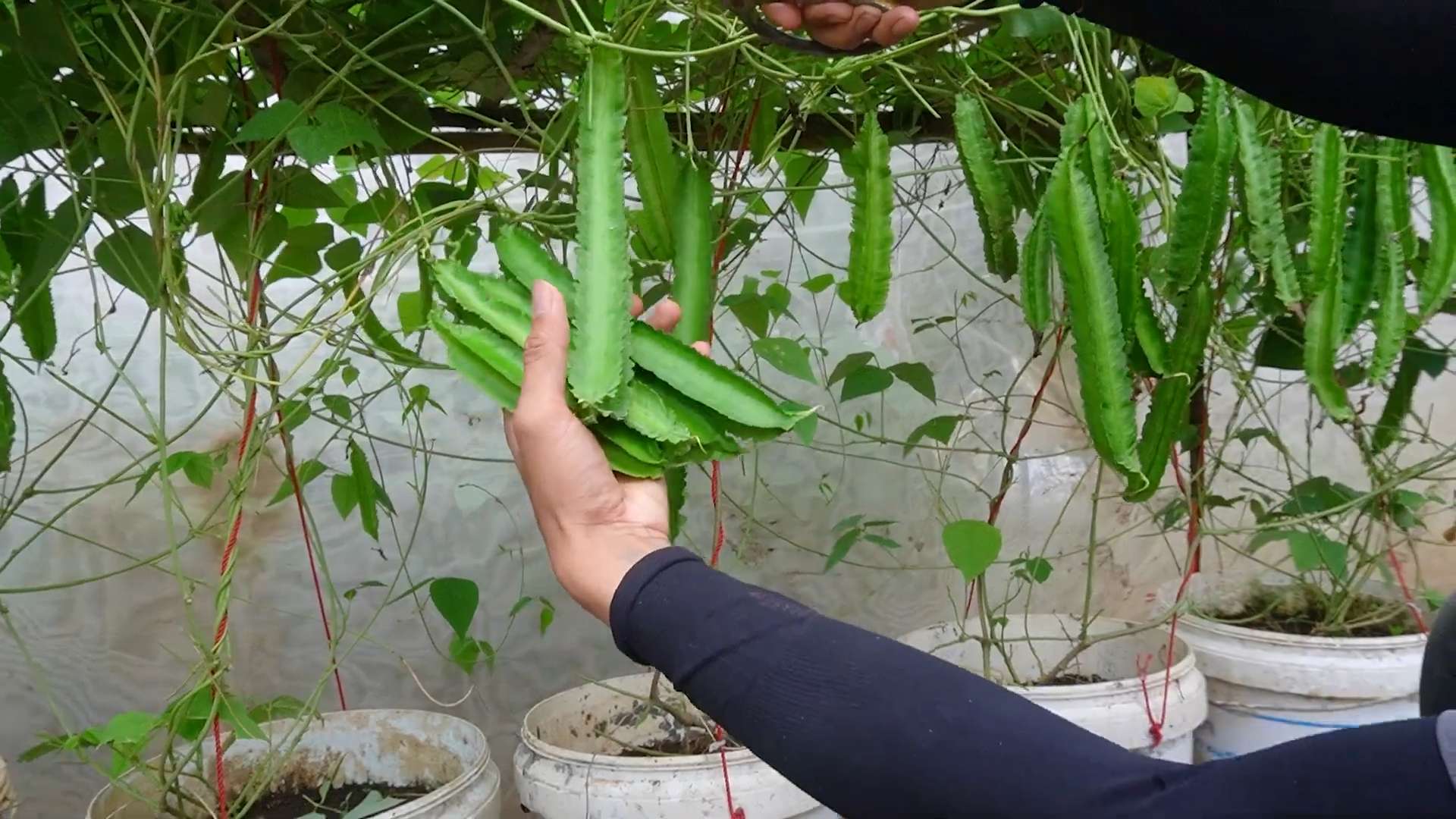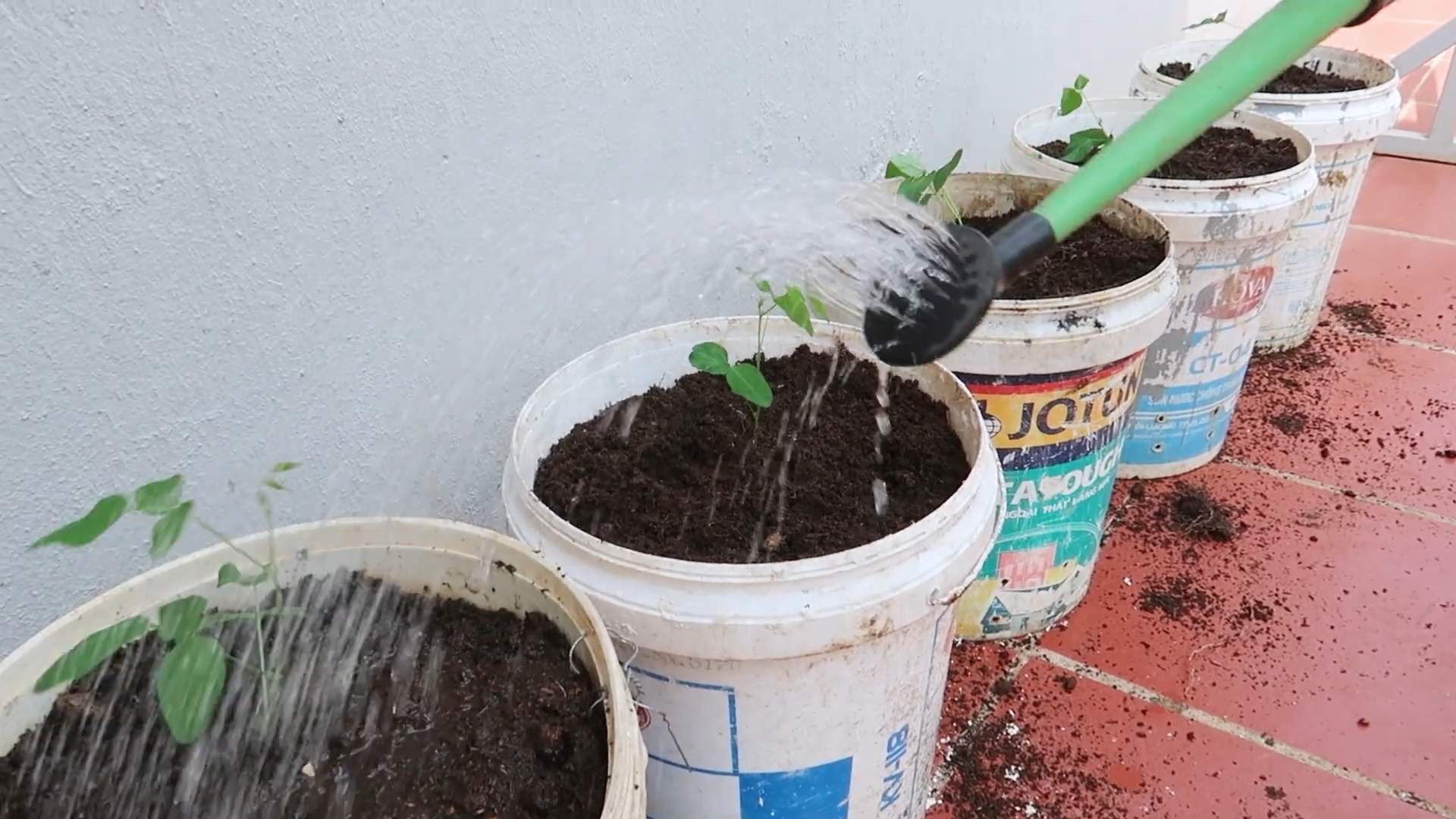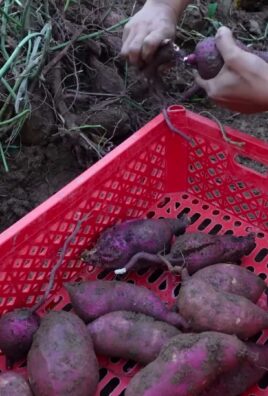Growing Winged Beans Method: Unlock the secrets to cultivating this nutritional powerhouse right in your backyard! Have you ever dreamt of harvesting vibrant, uniquely shaped beans that are not only delicious but also incredibly versatile? Well, get ready to turn that dream into reality! This DIY guide will walk you through every step of the process, from selecting the perfect spot to enjoying your bountiful harvest.
Winged beans, also known as Goa beans, have a rich history, particularly in Southeast Asia and Papua New Guinea, where they’ve been a staple food source for centuries. They’re not just a tasty addition to your meals; they’re packed with protein, vitamins, and minerals, making them a fantastic choice for health-conscious gardeners like myself.
Why should you try this DIY trick? Because growing winged beans method is easier than you might think, and the rewards are immense! Imagine fresh, homegrown beans gracing your dinner table, knowing you nurtured them from seed to plate. Plus, this climbing vine adds a beautiful, vertical element to your garden, maximizing space and creating a lush, green oasis. Whether you’re a seasoned gardener or just starting out, this guide will empower you to successfully cultivate these amazing beans and enjoy their many benefits. Let’s get started!

Growing Winged Beans: A Comprehensive DIY Guide
Hey there, fellow gardening enthusiasts! Today, I’m super excited to share my tried-and-true method for growing winged beans. These unique legumes, also known as asparagus peas or Goa beans, are not only delicious but also incredibly versatile. Every part of the plant is edible – the pods, leaves, flowers, seeds, and even the tubers! Plus, they’re nitrogen-fixing, which means they’re great for your soil. Let’s dive into how you can cultivate these amazing plants in your own backyard.
What You’ll Need
Before we get started, let’s gather all the necessary supplies. Having everything on hand will make the process much smoother.
* Winged bean seeds: You can find these online or at specialty garden centers.
* Well-draining soil: Winged beans aren’t too picky, but they thrive in soil that drains well.
* Compost or aged manure: To enrich the soil and provide essential nutrients.
* Trellis or support structure: These beans are climbers, so they need something to grow on.
* Gardening gloves: To protect your hands.
* Watering can or hose: For regular watering.
* Optional: Seed starting trays and potting mix (if starting indoors).
* Optional: Fertilizer (organic is best).
Preparing the Soil
Winged beans prefer slightly acidic to neutral soil with a pH between 6.0 and 7.5. Good drainage is crucial to prevent root rot.
1. Choose Your Location: Select a spot in your garden that receives at least 6-8 hours of sunlight per day. Winged beans love the sun!
2. Clear the Area: Remove any weeds, rocks, or debris from the planting area.
3. Amend the Soil: Dig in plenty of compost or aged manure to improve soil fertility and drainage. I usually add about 2-3 inches of compost and mix it thoroughly with the existing soil.
4. Test the Drainage: Dig a hole about a foot deep and fill it with water. If the water drains away within a few hours, your soil has good drainage. If it takes longer, you may need to add more organic matter or consider planting in raised beds.
Starting Winged Bean Seeds
You can start winged bean seeds either directly in the ground or indoors. Starting indoors gives you a head start, especially in cooler climates.
Starting Seeds Indoors (Optional)
1. Soak the Seeds: Soak the winged bean seeds in warm water for 24 hours before planting. This helps to soften the seed coat and improve germination rates.
2. Prepare Seed Starting Trays: Fill seed starting trays with a good quality potting mix.
3. Plant the Seeds: Plant the seeds about 1 inch deep in the potting mix.
4. Water Gently: Water the trays gently to moisten the soil.
5. Provide Warmth: Keep the trays in a warm location (around 70-75°F or 21-24°C). A heat mat can be helpful.
6. Keep Soil Moist: Keep the soil consistently moist, but not waterlogged.
7. Transplant Seedlings: Once the seedlings have developed a few sets of true leaves and the weather has warmed up (after the last frost), you can transplant them into your garden.
Direct Sowing
1. Wait for Warm Weather: Winged beans are sensitive to frost, so wait until the soil has warmed up to at least 65°F (18°C) before planting directly in the ground.
2. Soak the Seeds: As with starting indoors, soak the seeds in warm water for 24 hours.
3. Plant the Seeds: Plant the seeds about 1 inch deep and 4-6 inches apart.
4. Water Gently: Water the planting area gently to moisten the soil.
5. Mark the Rows: Use stakes or row markers to identify where you planted the seeds.
Providing Support: Trellising
Winged beans are vigorous climbers and need a sturdy trellis or support structure to grow on. This is crucial for maximizing yields and keeping the plants healthy.
1. Choose Your Trellis: There are many options for trellising winged beans, including:
* Bamboo stakes: Simple and inexpensive.
* Wire mesh: Provides a strong and durable support.
* Trellis netting: Lightweight and easy to install.
* Arbors or pergolas: A more decorative option.
2. Install the Trellis: Install the trellis before or shortly after planting the seeds or transplanting the seedlings. Make sure the trellis is securely anchored in the ground. I prefer using sturdy wooden posts and attaching wire mesh to them.
3. Guide the Vines: As the winged bean vines grow, gently guide them onto the trellis. They will eventually start climbing on their own, but a little help in the beginning can ensure they grow in the right direction.
Caring for Your Winged Bean Plants
Once your winged bean plants are established, it’s important to provide them with the care they need to thrive.
1. Watering: Water regularly, especially during dry periods. Winged beans need consistent moisture to produce healthy pods. Aim for about 1 inch of water per week.
2. Fertilizing: Winged beans are nitrogen-fixing, so they don’t need a lot of fertilizer. However, a light feeding of organic fertilizer every few weeks can help to boost growth. I like to use compost tea or fish emulsion.
3. Weeding: Keep the area around your winged bean plants free of weeds. Weeds can compete with the beans for nutrients and water.
4. Pest Control: Winged beans are relatively pest-resistant, but they can occasionally be affected by aphids, spider mites, or bean beetles. Inspect your plants regularly and take action if you notice any pests. You can use insecticidal soap or neem oil to control these pests.
5. Pruning: Pruning isn’t usually necessary, but you can trim the vines to encourage branching and bushier growth. This can also help to improve air circulation and reduce the risk of disease.
Harvesting Winged Beans
The best part of growing winged beans is, of course, harvesting and enjoying the delicious pods!
1. Harvest Time: Winged beans are typically ready to harvest about 2-3 months after planting. The pods are best harvested when they are young and tender, about 6-8 inches long.
2. Harvesting Technique: Use scissors or pruning shears to cut the pods from the vine. Be careful not to damage the plant.
3. Regular Harvesting: Harvest the pods regularly to encourage the plant to produce more. If you allow the pods to mature and dry on the vine, the plant will stop producing new pods.
4. Edible Parts: Remember that all parts of the winged bean plant are edible! You can harvest the leaves and flowers for salads, the seeds for cooking, and the tubers for roasting.
Enjoying Your Harvest
Winged beans are incredibly versatile in the kitchen. Here are a few ideas for how to enjoy your harvest:
* Steamed or stir-fried: Winged beans can be steamed or stir-fried like green beans.
* In salads: The young leaves and flowers can be added to salads for a unique flavor and texture.
* In soups and stews: Winged beans can be added to soups and stews for a hearty and nutritious meal.
* Roasted: The tubers can be roasted like potatoes.
* As a snack: Young, tender pods can even be eaten raw as a snack.
Troubleshooting
Even with the best care, you might encounter some challenges when growing winged beans. Here are a few common problems and how to address them:
* Poor germination: If your seeds aren’t germinating, make sure the soil is warm enough and that you’re keeping it consistently moist. Soaking the seeds before planting can also help.
* Slow growth: If your plants are growing slowly, make sure they’re getting enough sunlight and nutrients. A light feeding of organic fertilizer can help.
* Yellowing leaves: Yellowing leaves can be a sign of nutrient deficiency or overwatering. Check the soil drainage and consider adding some compost or fertilizer.
* Pest infestations: Inspect your plants regularly for pests and take action if you notice any. Insecticidal soap or neem oil can be effective for controlling aphids, spider mites, and bean beetles.
* Lack of flowering: If your plants aren’t flowering, it could be due to a lack of sunlight or excessive nitrogen in the soil. Make sure your plants are getting at least 6-8 hours of sunlight per day and avoid over-fertilizing with nitrogen-rich fertilizers.
Saving Seeds
If you

Conclusion
So, there you have it! Growing winged beans at home, while it might seem a little exotic at first, is surprisingly achievable and incredibly rewarding. We’ve walked through the process, highlighting the key steps to ensure your success, from selecting the right seeds to providing the necessary support for these vigorous climbers. But why should you dedicate your precious garden space to this unique legume?
Firstly, the nutritional benefits are undeniable. Winged beans are a powerhouse of protein, vitamins, and minerals, offering a delicious and healthy addition to your diet. Forget bland, store-bought vegetables; these beans boast a subtly sweet and nutty flavor that elevates any dish. Secondly, growing your own food is inherently satisfying. There’s a profound connection you forge with nature when you nurture a plant from seed to harvest, and the pride you’ll feel serving up your own homegrown winged beans is unmatched.
But beyond the health and satisfaction, growing winged beans offers a unique opportunity to diversify your garden and impress your friends and family. Imagine serving a stir-fry featuring these unusual, four-sided beans – a guaranteed conversation starter! Plus, the beautiful, fragrant flowers add an aesthetic appeal to your garden, attracting pollinators and creating a vibrant ecosystem.
Don’t be afraid to experiment! Try different varieties of winged beans to discover your favorite flavor profile. Some varieties are more heat-tolerant, while others might be better suited for cooler climates. Consider growing them alongside other climbing vegetables like cucumbers or pole beans to maximize your garden space. You can also explore different trellising methods to find what works best for your garden layout. Perhaps a simple bamboo teepee, a sturdy wire fence, or even allowing them to climb up a sturdy sunflower stalk.
And the best part? You’re not just limited to the beans themselves. The entire plant is edible! The young leaves can be steamed or stir-fried like spinach, the flowers can be added to salads, and the tubers can be roasted or boiled like potatoes. Talk about maximizing your harvest!
We strongly encourage you to give growing winged beans a try. It’s a fun, educational, and ultimately delicious experience. Don’t be intimidated by the perceived complexity; with a little planning and care, you’ll be enjoying a bountiful harvest in no time.
Once you’ve embarked on your winged bean growing adventure, we’d love to hear about your experiences! Share your tips, tricks, and triumphs in the comments below. Let’s build a community of winged bean enthusiasts and learn from each other. What varieties did you try? What challenges did you face? What delicious recipes did you create? Your insights will be invaluable to other aspiring gardeners. So, grab your seeds, prepare your soil, and get ready to discover the joys of growing winged beans! Happy gardening!
Frequently Asked Questions (FAQ)
What is the best time to plant winged beans?
The ideal time to plant winged beans is after the last frost in spring, when the soil has warmed up to at least 65°F (18°C). Winged beans are sensitive to cold temperatures, so it’s crucial to avoid planting them too early. In warmer climates with longer growing seasons, you can also plant them in early summer for a fall harvest. Consider your local climate and growing season when determining the optimal planting time. A good rule of thumb is to plant them at the same time you would plant other warm-season crops like tomatoes or peppers.
How much sunlight do winged beans need?
Winged beans thrive in full sun, requiring at least 6-8 hours of direct sunlight per day. Adequate sunlight is essential for healthy growth, flowering, and bean production. If you live in a particularly hot climate, some afternoon shade can be beneficial to prevent the plants from overheating. However, insufficient sunlight can lead to stunted growth and reduced yields. Choose a planting location that receives ample sunlight throughout the day.
What kind of soil is best for growing winged beans?
Winged beans prefer well-drained, fertile soil with a slightly acidic to neutral pH (6.0-7.0). Amend the soil with compost or other organic matter to improve drainage and fertility. Avoid heavy clay soils that retain too much moisture, as this can lead to root rot. If your soil is particularly poor, consider growing winged beans in raised beds or containers with a high-quality potting mix. Regular soil testing can help you determine the pH and nutrient levels of your soil and make necessary adjustments.
How often should I water winged beans?
Winged beans need consistent moisture, especially during hot and dry periods. Water deeply and regularly, ensuring that the soil remains consistently moist but not waterlogged. Avoid overhead watering, as this can promote fungal diseases. Drip irrigation or soaker hoses are excellent options for delivering water directly to the roots. Mulching around the plants can help retain moisture and suppress weeds. Check the soil moisture regularly and adjust your watering schedule accordingly.
What kind of support do winged beans need?
Winged beans are vigorous climbers and require sturdy support to grow properly. Provide a trellis, fence, or other structure for the vines to climb on. The support should be at least 6-8 feet tall to accommodate the plant’s growth. Ensure that the support is strong enough to withstand the weight of the mature vines and beans. You can also train the vines to climb up a sturdy sunflower stalk or other tall plant.
How long does it take for winged beans to mature?
Winged beans typically take 90-120 days to mature from planting to harvest. The exact time will depend on the variety, climate, and growing conditions. You can start harvesting the beans when they are young and tender, about 6-8 inches long. Regular harvesting will encourage the plant to produce more beans. The tubers can be harvested in the fall after the plant has died back.
Are winged beans susceptible to any pests or diseases?
Winged beans are generally resistant to pests and diseases, but they can be susceptible to aphids, spider mites, and fungal diseases like powdery mildew. Monitor your plants regularly for signs of infestation or disease. Treat any problems promptly with appropriate organic pest control methods or fungicides. Good air circulation and proper watering practices can help prevent fungal diseases.
Can I eat the entire winged bean plant?
Yes, the entire winged bean plant is edible! The young leaves can be steamed or stir-fried like spinach, the flowers can be added to salads, the beans can be eaten raw or cooked, and the tubers can be roasted or boiled like potatoes. This makes winged beans a highly versatile and nutritious crop.
How do I store winged beans?
Fresh winged beans can be stored in the refrigerator for up to a week. For longer storage, you can blanch and freeze them. The tubers can be stored in a cool, dry place like potatoes. Dried winged beans can be stored in an airtight container for several months.
Can I grow winged beans in containers?
Yes, you can grow winged beans in containers, but you’ll need to choose a large container (at least 10 gallons) with good drainage. Use a high-quality potting mix and provide adequate support for the vines to climb on. Container-grown winged beans may require more frequent watering and fertilization than those grown in the ground.
How can I encourage more bean production?
To encourage more bean production, ensure that your winged beans receive adequate sunlight, water, and nutrients. Regular harvesting will also stimulate the plant to produce more beans. You can also try pinching off the tips of the vines to encourage branching and more flower production. Fertilizing with a balanced fertilizer or compost tea can also help boost bean production.




Leave a Comment